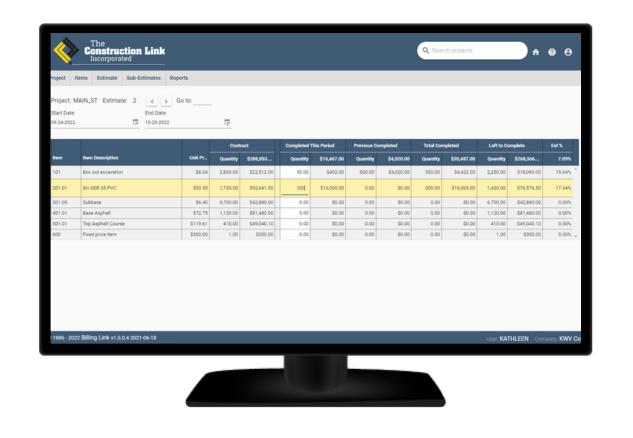
How to Create Construction Invoices: A Step-by-Step Guide
The Key to Efficient Construction Billing
Creating accurate construction invoices is a vital skill that ensures smooth financial transactions and reinforces your business’s credibility. These documents provide detailed records that communicate the scope, duration, and cost of the construction work completed. Beyond triggering the payment process, construction invoices support financial tracking and can even resolve disputes by providing a clear account of the services rendered.
In the heavy construction sector, where tasks are complex and range from earthmoving for new roads to laying down infrastructure for utilities, construction invoices must be specific, clear, and accurate. This detailed invoicing is essential to justify the costs and progress of a project to those who may not be familiar with the construction process.
Recognizing the challenges involved in construction invoicing, we have put together this in-depth guide on how to create construction invoices. We’ll help you understand the fundamental aspects of construction invoicing, along with step-by-step instructions on how to put them together.
Additionally, we’ll introduce you to TCLI’s Billing Link®️ software, which is designed to assist in creating detailed and accurate invoices, allowing you to focus more on the construction work and less on the paperwork.
Whether your goal is to improve your financial workflows, ensure timely payments, improve client satisfaction, or achieve other objectives, let us help you understand this important component of operating an efficient and effective construction business.

Understanding Construction Invoices and Their Importance
A construction invoice acts as a link between the physical work completed on a project site and the financial acknowledgment of that work. To put it simply, a construction invoice is a bill that details the services provided, the materials used, the labor expended, and the costs incurred during a construction project, representing a formal payment request.
A well-structured invoice provides a clear breakdown of all charges, which is important for transparent communication. This clarity benefits not just the client by setting understandable expectations but also supports the contractor in justifying the project costs, thereby paving the way for smoother financial transactions.
Construction invoices serve multiple purposes. Firstly, they are fundamental to maintaining cash flow—vital for the health and operation of any construction business. Timely and precise invoicing ensures that funds are available for ongoing expenses, including payroll, materials, and equipment rentals.
Secondly, construction invoices are invaluable in financial record-keeping, enabling businesses to track income and expenses accurately for reporting and tax purposes.
Moreover, in disputes or audits, a thoroughly documented invoice can be an important piece of evidence. It can demonstrate what work was agreed upon, what was completed, and how much was charged, providing a solid basis for any necessary negotiations or resolutions.
While creating construction invoices might seem like a straightforward administrative task, it is more importantly a strategic practice for financial management and enhancing client communication.
As we dive deeper into construction invoices and how to create them, remember that each invoice reflects the value of your work and professionalism, which is essential for securing successful project delivery and fostering enduring client relationships.
The Essential Components of a Construction Invoice
Understanding the components of a construction invoice is key to ensuring that all parties involved have a clear understanding of the project costs and the services rendered. Here, we outline the key elements in a construction invoice that uphold transparency, accuracy, and professionalism.
Header Information
Every construction invoice should start with the basics—your company’s name, address, contact information, and, if applicable, your logo. This information plays an important role in ensuring your invoice is promptly recognized and processed by the client’s accounts payable department.
Invoice Number and Date
Assigning a unique invoice number and including the date of issuance are important for record-keeping and tracking, helping both you and your client manage payments and financial records effectively.
Client Details
Just as your business information is important, so too are the details of your client. Include their name, address, and any other contact information required to support a seamless construction billing process.
Project Description
A brief but detailed description of the project provides context for the construction invoice. This might include the project’s name, location, and a summary of the work performed.
Detailed Breakdown of Services
Perhaps the most important component, this section should itemize the services provided, materials used, labor hours, and any other expenses. Each item should be clearly described along with its corresponding costs, ensuring the client fully understands what they are being billed for.
Total Amount Due
After itemizing the services and costs, the total amount due should be clearly stated. This includes any taxes, discounts, or additional fees.
Payment Terms
Specify the payment due date, acceptable payment methods, and any late payment fees or terms. This sets clear expectations for the payment timeline.
Notes or Additional Information
This optional section can be used for thank-you messages, reminders about upcoming projects, or any other personalized notes that can further strengthen client relations.
Incorporating these elements into your construction invoice template allows you to create a document that facilitates timely and accurate payments while reinforcing your commitment to professionalism and transparency. Easy-to-understand invoices are fundamental in establishing sound financial practices and nurturing strong, trust-filled client relationships.
A Step-By-Step Guide on How to Create Your Construction Invoice
Creating a construction invoice requires keen attention to detail to ensure every aspect of the work done is accurately accounted for and billed. In this section, we provide a detailed walkthrough for generating an invoice for construction work, highlighting the significant role that construction invoicing software plays in streamlining this process.
Gather Project Information
Before drafting your invoice, compile all necessary project details, including the client's information, project description, dates of service, and any contract or agreement numbers. This step ensures that your invoice is comprehensive and grounded in the specifics of the project.
Detail the Services and Costs
Using the project details, list every service you've provided. Include a clear description of each service, the date it was performed, and the corresponding charge. This might range from labor and materials to equipment use and any subcontracted work. Transparency here is key to building trust with your client.
Include Additional Charges
Beyond the direct services, remember to include any additional costs incurred during the project. This could be expenses related to permits, special materials, or unexpected labor. Providing a brief explanation for these charges helps clarify their necessity.
Utilize Construction Invoicing Software
Construction invoicing software simplifies itemizing services and costs. It also ensures that calculations are accurate and that nothing gets overlooked. Features like construction invoice templates and automatic calculations remove the risk of human error, streamlining the invoice creation process.
Finalize Your Invoice
First, sum up all the services and additional charges to determine the total amount due. Ensure this figure is prominently displayed on your invoice.
Next, clearly state your payment terms, including due dates, accepted payment methods, and any late fees. This clarity is important for maintaining timely payments and healthy cash flow.
Finally, review your invoice for accuracy and completeness. Ensure all services are listed and all costs are accounted for. Once satisfied, send the invoice to your client, using their preferred method of receipt.
Creating a construction invoice doesn’t have to be a complicated process, especially if you’re using the right approach and tools. Through careful preparation and the integration of technology like construction invoicing software, you can create construction invoices that streamline the billing process, underscore your professionalism, and foster lasting trust with your clients.
Best Practices for Construction Invoicing
Implementing the following best practices can greatly enhance the efficiency of your construction billing process, ensuring accuracy and boosting customer satisfaction.
Keep Comprehensive Records
Keeping comprehensive records is crucial. Document every aspect of the project, including executed work, materials consumed, and any project changes. This detailed documentation not only bolsters the accuracy of your invoices but also serves as a protective measure in case of disputes.
Prioritize Clear and Ongoing Communication
Clear, consistent communication with clients regarding billing expectations, timelines, and any adjustments is key to averting misunderstandings and cultivating positive relationships. Effective communication strategies ensure clients are well-informed and confident in the billing process.
Regularly Evaluate Billing Practices
An ongoing assessment of your billing methods helps to identify areas for improvement, ensuring your practices remain efficient and client-focused. Utilizing client feedback and insights gained from software solutions can direct enhancements, smoothing the path for your team and your clients alike.
Adhering to these invoicing best practices showcases your business’s reliability and professionalism while building trust with clients, a fundamental component for the sustained financial health of your operations.
Streamline Your Construction Billing Process With TCLI’s Billing Link®️
TCLI’s Billing Link®️ software makes it easy to create, manage, and track construction invoices. Easily integrated into your construction billing routine, Billing Link®️ stands out as a transformative tool designed to enhance your invoicing capabilities.
 Rapid Invoice Creation
Rapid Invoice Creation
Billing Link®️ is an efficient tool that enables the fast creation of construction invoices. With its progress billing feature, the software calculates quantities completed for the current period, juxtaposing them against previous periods, the overall total, and the remaining total. This ensures that each progress invoice builds upon the last, seamlessly incorporating essential elements like stored materials, retainage, and previously paid amounts. The result is a streamlined process that saves time and enhances accuracy in every invoice generated.
Centralized Construction Billing Organization
Achieving full visibility into your invoicing process is effortless with Billing Link®️. The software consolidates all your invoices in one centralized location, providing a comprehensive overview at a glance. Whether you need to track invoices you've created, sent, or those paid by your customer, Billing Link®️ eliminates the need to sift through various systems and spreadsheets, offering a high level of organization.
Save and Print Professional Invoices
Once your entries are finalized, Billing Link®️ can generate sleek, professional invoices ready to be printed or downloaded as a PDF. This feature ensures that your invoices uphold the highest standards of professionalism while also allowing for easy distribution to your customers.
Instant Billing Status Overview
The invoice summary feature of Billing Link®️ offers a snapshot of your billing status with just one click. This intuitive summary displays each invoice by pay period in an easy-to-read format, detailing the invoice number, date sent to the customer, billed amount, amount paid, and the balance owed. This instant overview simplifies tracking and managing invoices, making it easier than ever to stay on top of your billing status.
Integrating TCLI's Billing Link®️ into your billing process streamlines the creation and management of construction invoice documents while instilling your operation with unmatched professionalism and efficiency. Discover more about how Billing Link®️ can enhance your construction billing efforts by visiting our product page.
Final Thoughts on Effective Construction Invoicing
This guide has highlighted the important role of clear, accurate construction invoices in managing projects and nurturing client relationships. Having an effective invoicing process makes your financial transactions smoother, which in turn bolsters your business’s credibility and trust with clients.
Integrating tools like Billing Link®️ is essential for businesses aiming to streamline their billing and payment processes. This software transforms the task of construction invoice creation into a streamlined, efficient operation, ensuring accuracy and professionalism.
For further insights on creating effective construction invoices, resources like Paystub.org’s article about how to make a contractor invoice and this construction invoice template from the Florida Department of Transportation are invaluable.
TCLI also stands ready to assist with any questions or to discuss how Billing Link®️ can meet your specific needs. Feel free to reach out to us; we're committed to enhancing your billing processes, ensuring efficiency and client satisfaction.




